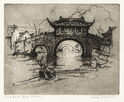
19th, 20th & 21st Century Fine Prints
707-546-7352 · fax 707-546-7924 · web: www.annexgalleries.com · email: artannex@aol.com
Lucille Douglass Biography
Lucille Douglass
American
1878–1935
Biography
Lucille Douglass was born on November 4, 1878, in Tuskegee, Alabama, the daughter of Walton Eugene Douglass (a Civil War veteran) and Mary Sinclair (Mollie) Douglass. She grew up in a large house but in the "genteel poverty" that characterized much of the nineteenth-century, postbellum South. Little is known about Douglass's early years, except that she was a sickly child who spent a great deal of time reading, favoring books about travels to distant and exotic lands.
Douglass received her A.B. in 1895 at the age of seventeen at Alabama Conference Female College, a forerunner of Huntingdon College, where her mother taught. Unfortunately, records do not survive to describe Douglass's course of study, though it seems safe to assume that she continued to receive art training from her mother, a practice begun when Douglass was a child.
In 1899 Douglass moved to Birmingham, where she made a living as both an artist and an art teacher. She occupied a studio in the old Watts Building between 1901 and 1908. The 1907 city directory listed her as a "china painter." In 1908 she and seven other female artists formed the Birmingham Art Club.
For several summers she attended the Art Students League in New York City, though there is no record with whom she studied. Between the years 1909 and 1912, she received art training in Europe. In Paris she studied with Lucien Simon, René Menard and Alexander Robinson. With two exhibits of her paintings displayed in Paris in 1911, she was on her way to establishing herself as an artist.
By 1913 Douglass had returned from Europe. She spent that summer with artist Isabelle Percy (who married George P. West in 1916), in Oakland, California. Her life took a fresh turn in 1920, when the forty-two-year-old Douglass accepted a position with the Methodist Missionary Society. She was employed to oversee a workshop in Shanghai in which Chinese women hand-colored an early form of photographic slide used by speakers to publicize the missionary work of the society. While in China, Douglass became close friends with two female writers whose books she would eventually illustrate. Florence Wheelock Ayscough was born in Shanghai to missionary parents and educated in New England. She became a scholar of China and its literature, writing books about China and translating the works of early Chinese poets. Four of her books were illustrated by Douglass, the first three with ink drawings and the last with etchings.
The second friend Douglass made in China was Helen Churchill Candee, who had, among other things, the distinction of surviving the 1912 sinking of the HMS Titanic. Roughly two decades apart in age, the two traveled together from November 1926 until January 1927. This journey led them through the Far East-first to Indochina, then to Siam, and on to Java and BaIi. This adventure resulted in the 1927 publication of Candee's book, New Journeys In Old Asia, for which Douglass executed twenty-one etchings. It was also on this journey that Douglass first visited Angkor. Candee had been there before and had published the book Angkor the Magnificent in 1924.
For the last years of her life, Douglass made New York her home base, though she traveled frequently to Europe and occasionally visited Birmingham. From November 1928 until late spring of 1929, she was a faculty member of a "floating university." On the ship President Wilson, Douglass taught art history, sketching, and painting to a hundred "boys and girls" of unspecified age as the ship sailed around the world. An article in the November 6, 1928, New York Evening Post referred to Douglass as "one of America's best known painters and etchers" and stated that the ship's itinerary would include such exotic places as Siam, BaIi, Java, and Singapore, as well as "all the cities ... on the more usual type of tour."
After an illness that lasted several months Douglass died on September 26, 1935, in the home of a friend in Andover, Massachusetts. Her remains were cremated and, in the following year, flown to Angkor where they were spread around what was described as "a magnificent mango tree."
Douglass' work is held in the Metropolitan Museum of Art, NY, the Library of Congress, NY, Yale University Art Galley, CT; the Detroit Institute of Arts, MI; the High Museum, Atlanta, GA; and the Birmingham Museum of Art, AL, among others.


